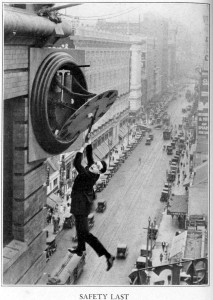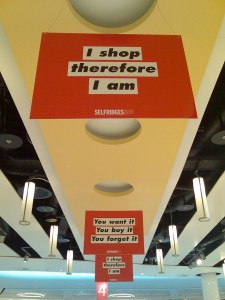Chapter 3. Culture
3.4. Culture as Restriction: Rationalization and Commodification
The previous section examined culture in its innovative guise. Culture, as a source of innovation, is the site of “all thoughts, dreams, ideas, beliefs, myths, intuitions, and inspirations brought into being by the human imagination since the dawn of consciousness” as Wade Davis (2002) put it. Culture provides the imaginative capacity that enables humans to go beyond the “given” of their biological and social reality. The innovations of high culture in expanding the range of human sensibility and the inventiveness of pop culture, subculture, and globally hybrid culture in creating and diffusing new cultural forms attests to the innovative side of culture. However, culture can also be examined in its restrictive guise, as a dimension of social life that confines human possibilities. Two contemporary modes of culture as restriction can be seen in the processes of rationalization and consumerism.
Rationalization

Max Weber’s analysis of modern society centers on the concept of rationalization. Arguably, the primary focus of Weber’s entire sociological oeuvre was to determine how and why Western civilization and capitalism developed where and when they did. Why was the West the West? Why did the Western world modernize and develop modern science, industry, military, and democracy first when, for centuries, Asia, the Indian subcontinent, and the Middle East were technically, scientifically, and culturally more advanced than the West?
Weber argued that the modern forms of society developed in the West because of the process of rationalization: the general tendency of modern institutions and most areas of life to be transformed by the application of instrumental reason — choosing the most efficient means to achieve defined goals — and the overcoming of “magical” thinking (which in Chapter 1. An Introduction to Sociology was referred to as the “disenchantment of the world”). In modernity, everything is subject to the cold and rational gaze of the scientist, the technician, the bureaucrat, and the business person. “There are no mysterious incalculable forces that come into play… rather… one can, in principle, master all things by calculation. This means that the world is disenchanted” (Weber, 1919). As impediments toward rationalization like religious belief and tradition were removed, organizations and institutions were restructured on the principle of maximum efficiency and specialization. Older, traditional (inefficient) types of organization were gradually eliminated. Weber’s question was, what are the consequences of rationality for everyday life, for the social order, and for the spiritual fate of humanity?
Through rationalization, all of the institutional structures of modern society are reorganized on the principles of efficiency, calculability, and predictability. These are the bases of the “technical and economic conditions of machine production” that Weber refers to in The Protestant Ethic (1904). See the discussion in Chapter 15. Religion. As rationalization transforms the institutional and organizational life of modernity, other forms of social organization are eliminated and other purposes of life — spiritual, moral, emotional, traditional, etc.—become irrelevant or sidelined. Life becomes irrevocably narrower in its focus, and other values are lost. People’s attitude towards their own lives becomes oriented to maximizing their own efficiency, and eliminating non-productive pursuits and downtime.
This is the key to Weber’s metaphor of the iron cage in which human are trapped by their own systems of efficiency. Other ways and possibilities of life are abandoned because they are “inefficient” and cannot compete with rationalized organizational structures. Weber argues that the combination of new powers of production and organizational effectiveness and the increasingly narrow specialization of tasks lead to the loss of the Enlightenment ideal of reason: a well-rounded individual and a “full and beautiful humanity.” Having forgotten its spiritual or other purposes of life, humanity succumbed to an order “now bound to the technical and economic conditions of machine production” (Weber, 1904). The modern subject in the iron cage is essentially a narrow specialist or bureaucrat, “only a single cog in an ever-moving mechanism which prescribes to him an essentially fixed route of march” (Weber, 1922).
One of the consequences of the rationalization of everyday life is stress. In 2010, 27% of working adults in Canada described their day-to-day lives as highly stressful (Crompton, 2011). Twenty-three per cent of all Canadians, aged 15 and older, reported that most days were highly stressful in 2013 (Statistics Canada, 2014). In the case of stress, rationalization is a double-edged sword in that it allows people to get more things done per unit of time more efficiently in order to “save time,” but ironically efficiency — as a means to an end — tends to replace other goals in life and becomes an end in itself. The focus on efficiency means that people regard time as a kind of limited resource in which to achieve a maximum number of activities. The irrationality of rationalization is: Saving time for what? Are people able to take time for activities (including sleep) which replenish them or enrich them? Even the notions of “taking time” or “spending quality time” with someone use the metaphor of time as a kind of expenditure in which people use up a limited resource. Stress is in many respects a product of the modern “rational” relationship to time. As seen in the table below, for a significant number of people, there is simply not enough time in the day to accomplish what they set out to do. This is an outcome of the restrictive quality of the rationalization of culture.
| Perceptions of time | 15 and over | 15 to 24 | 25 to 34 | 35 to 44 | 45 to 54 | 55 to 64 | 65 to 74 | 75 and over |
|---|---|---|---|---|---|---|---|---|
| Do you plan to slow down in the coming year? | 19% | 13% | 16% | 21% | 22% | 23% | 16% | 20% |
| Do you consider yourself a workaholic? | 25% | 22% | 29% | 31% | 28% | 23% | 18% | 14% |
| When you need more time, do you tend to cut back on your sleep? | 46% | 63% | 60% | 59% | 45% | 31% | 20% | 15% |
| At the end of the day, do you often feel that you have not accomplished what you had set out to do? | 41% | 34% | 46% | 48% | 46% | 40% | 29% | 35% |
| Do you worry that you don’t spend enough time with your family or friends? | 36% | 34% | 47% | 53% | 41% | 27% | 14% | 10% |
| Do you feel that you’re constantly under stress trying to accomplish more than you can handle? | 34% | 35% | 41% | 47% | 40% | 27% | 15% | 10% |
| Do you feel trapped in a daily routine? | 34% | 33% | 41% | 46% | 40% | 28% | 15% | 15% |
| Do you feel that you just don’t have time for fun any more? | 29% | 20% | 36% | 43% | 38% | 23% | 11% | 11% |
| Do you often feel under stress when you don’t have enough time? | 54% | 65% | 66% | 69% | 59% | 41% | 22% | 16% |
| Would you like to spend more time alone? | 22% | 19% | 30% | 35% | 24% | 15% | 9% | 7% |
| Note. The percentages represent the proportion of persons who answered “yes” to the questions on perceptions of time. Source: Statistics Canada, General Social Survey, 2010 (Statistics Canada, 2011). |
||||||||
Commodity, Commodification, and Consumerism as a Way of Life

A commodity is an object, service, or a “good” that has been produced for sale on the market. Commodification is the process through which objects, services, or goods are increasingly turned into commodities. Through commodification, they become defined more in terms of their marketability and profitability than by their intrinsic characteristics. Prior to the invention of the commodity market, economic life revolved around bartering or producing for immediate consumption. Real objects like wool or food were exchanged for other real objects or were produced for immediate consumption according to need. The development of commodity exchange with the rise of capitalism introduced a strange factor into this equation because, in the marketplace, objects are exchanged for money. Money can be used to buy other objects or services, or it can be accumulated and used later, but its unique quality is that it is indifferent to where it is used and what it is used for (Simmel, 1978/1900). In commodity exchange, commodities are produced in order to be sold in the market for money. Their value is determined not just in regard to their unique qualities, their purpose, or their ability to satisfy a need (i.e., their “use value”), but also their monetary value or “exchange value” (i.e., their price). When someone asks what something is worth today, they are usually referring to its price.
This monetization of value has a number of strange qualities. In the first place, the medium of money allows for incomparable, concrete things or use values to be quantified and compared. Twenty dollars will get the consumer a chicken, a novel, or a hammer; these fundamentally different things all become equivalent from the point of view of money. It is strange in the second place because the use of money to define the value of commodities makes the commodity appear to stand alone, as if its value was independent of the context in which it was created, the labour that produced it, or the needs it was designed to satisfy. Commodities seem to have a life ot their own. In the third place, people see the object and imagine the qualities it will endow them with: a style, a fashionability, a street credibility, a personality type, or a tribal affiliation (e.g., are you a PC person or a Mac person?). They do not recognize the labour and the social relationships of work that produced it, nor the social relationship that ties them to its producers when they purchase it. Instead the commodity has an agency of its own. It will make the consumer smarter, sharper, sexier, or snazzier.
Karl Marx (1818-1883) called this phenomenon commodity fetishism (1867), the mistaken belief that commodities themselves hold or create values or give valuable attributes to their possessors, instead of recognizing that it is humans and human social processes that give value to things. Why are diamonds more valuable than water for example? They might be rarer than fresh water but they do not serve any practical function like water does. They are given value purely by human choice or agreement.

With the increased importance of maintaining high levels of commodity turn over and consumption that emerged with the system of late capitalism, commodity fetishism plays a powerful role in producing ever-new wants and desires. Consumerism becomes a way of life. Consumerism refers to the way in which people define themselves in terms of the commodities they purchase. To the degree that people’s identities become defined by the pattern of their consumer preferences, the commodity no longer exists to serve their needs but to define their needs. As a form of cultural practice, consumerism ties people’s identities to the circuits of capital accumulation and restricts the possibilities of individuation and personal expression. As Barbara Kruger put it, the motto of consumer culture is not “I think therefore I am” but “I shop therefore I am.” Thinking is precisely what consumerism entices people not to do, except insofar as they calculate the prices of things.
Media Attributions
- Figure 3.34 Safetylast-1 by Harold Lloyd and Wesley Stoutvia (1928), An American Comedy, via Wikimedia Commons, is in the public domain.
- Figure 3.35 I shop, therefore I am by Mark Hillary, via Flickr, is used under a CC BY 2.0 licence.
- Figure 3.36 DSC00093 by Jose Antonio Gelado, via Flickr, is used under a CC BY-NC 2.0 licence.

